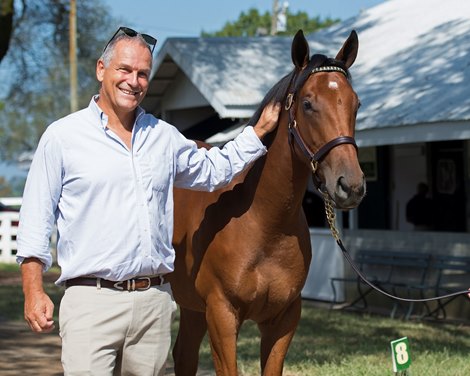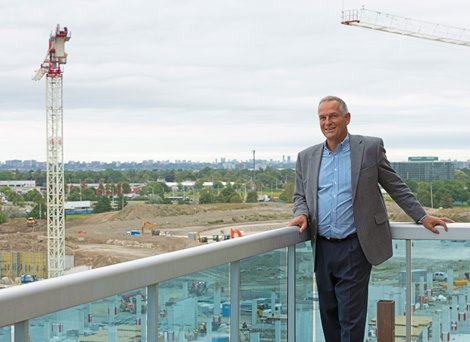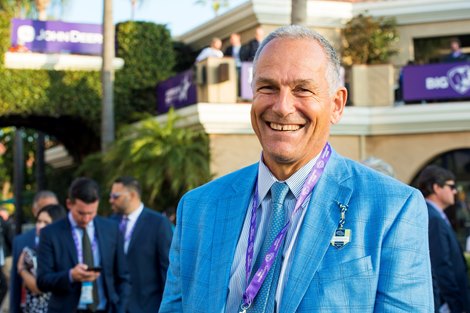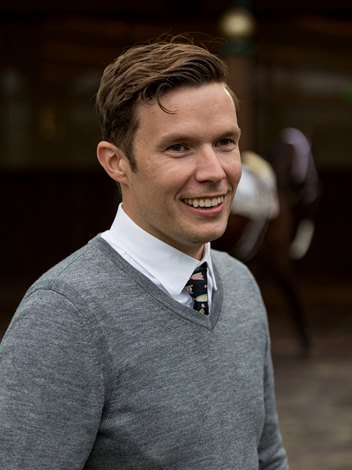Being the son of a Canadian Hall of Famer, Mel Lawson, has a way of instilling the sport in your genes, and while some travel down different avenues, the horse always finds a way back into the picture, as it did for Woodbine CEO Jim Lawson. Hockey player turned law student, Lawson was always close to the sport, which he has enriched in Canada for the past 15 years. Now at 65, he plans to slow down and spend more time with family but will keep the beloved Ontario racetrack in view, acting as the executive chair.
Before traveling overseas for the International Conference of Horseracing Authorities, Lawson spoke with BloodHorse MarketWatch about his remarkable career with Woodbine Entertainment.
MarketWatch: You became the CEO of Woodbine Entertainment in 2015 but have been with Woodbine since 2008. Walk me through the evolution of your career with the Canadian racetrack.
Jim Lawson: I went on the Woodbine board in 2008, became chairman of the board in 2012, and executive chair from 2013-15. Then I became CEO in 2015, and now I’m transitioning back to executive chair.
MW: You grew up watching your father have an immense love for the sport as an owner and breeder. What made you want to return to Thoroughbred racing after a professional stint on the National Hockey League and getting your law degree?
Sign up for BloodHorse Daily
JL: From the time I was young, I recall horses and watching horse racing as early as when I was 7- or 8-years-old. My father had horses from 1965 until 2011; growing up, I started to go to the racetrack with him. He ran a humble stable; he might have always had two or three mares and two or three 2-year-olds each year, expanding to seven or eight winners yearly. Over that period, he won over 70 stakes races with many excellent horses. He won six different Sovereign Awards with various champions.
(Mel Lawson was inducted into the Canadian Horse Racing Hall of Fame in 2010. His Sovereign Award winners include Ruthie’s Run, 1974 champion 2-year-old filly; Eternal Search, 1981 champion sprinter, 1982-83 champion older mare; Let’s Go Blue, 1986 champion older horse; and, Ginger Gold, 2001 champion 2-year-old filly)
He was a real student of the game. We used to sit down, and he would have the sales catalogs for the Keeneland Yearling Sale. I would have the sales results from either the Thoroughbred Record or the BloodHorse, and I would go through the sales results for him, and he would monitor how the breeding and the sires he was interested in were selling. As a kid, it was fun for me, a little bit of a task, but it was interesting.
I remember going to Claiborne Farm when I was 9, and Bold Ruler was there. My dad was fast, long friends for 40 years or more with Dr. Robert Copelan in Paris, Ky. Dr. Copelan pioneered equine surgery worldwide in the 70s and 80s. He was the leading equine surgeon in the world.

Jim Lawson at the Keeneland September Yearling Sale
I had an upbringing in the industry, but I ventured off. I was a hockey player. I went to Brown University and played, and then I was drafted in the National Hockey League and played in the Montreal Canadiens organization. I went from Brown to pro hockey to law school and then did private equity, but I never envisioned ever getting involved in the horse racing business. I liked horses and horse racing a bit, and I hoped someday I’d have the financial capability to own a horse or two, but I never envisioned that I would be working in the industry.
Much of my legal practice involved real estate and infrastructure financing worldwide. I was at an excellent law firm and did significant developments and financing worldwide. Woodbine sits on 683 acres, and they approached me in 2008 and said, ‘We’ve got 683 acres of land, we’ve entered into this agreement with the Cordish Companies out of Baltimore to redevelop the Woodbine land, and it’s just not going anywhere. We’d like you to come in, join the board, take a look at this, and form a real estate committee to try and figure out what to do with the land and deal with the Cordish group, who has a long-term land lease on about 250 acres of the Woodbine land.’
MW: In 2019, you led the team that helped secure the CA$105 million, 19-year funding agreement with the Ontario government to help stabilize the industry for the breeders, owners, and trainers. Discuss that achievement.
JL: It was critical to remember that period and what happened. In 1999, the provincial government of Ontario wanted to get into gaming on some basis, but they needed to learn how to do it. The path of least resistance and capital was to partner up with the racetracks so they didn’t have to spend the money. They already had sizable premises and a clientele by putting the slot machines into racetracks. The racetrack industry negotiated a 20% take on the gross gaming revenue, in lieu of a participation rent, for housing the slot machine in the racetracks.
Woodbine and Mohawk were the jewels of that program, and for a long time, Woodbine was held out in North America as a way to do this because the purses were large, and there was money flowing in. From 1999 until 2012, Woodbine’s net revenue from that slot machine program grew to CA$150 million. Woodbine had a lot of money for purses, to invest in its capital, to build modern paddocks, and to upgrade the backstretch barns. Technology was another essential aspect of what occurred over that time and expanded the off-track betting network.
When the government came along in 2012 and capped the program, they did it without thinking about it and within a one-year notice because that was what the contract provided. Woodbine had been thriving on this money and built their business around it. In 2013, when this money stopped flowing into the industry, everyone in the province was sent back on their heels. At Woodbine alone, we had to let go of 300 people overnight. We had to restructure our purses and pull back on our capital spending, which was doomsday for the industry.
The government was short-sighted; they needed to take the time to understand the considerable economy related to this industry. As many as 25,000 people and the backlash was huge; people stopped buying horses and were getting rid of them. Certainly, people fled the industry and stopped breeding; it was a disaster. The province quickly lobbied, primarily led by Woodbine but also by the horse people’s associations, and others lobbied hard, and we got some transition funding to try and ease the pain. We were working with about half of the previous revenue and had to change our way completely.
This led to a transition of how we would make this work from year to year and get the government to understand that that was never going to work. There’s a breeding cycle and long-term investment in horses, and people will only do it when they trust the government and, secondly, can’t have any confidence when it’s year to year.
Ultimately, the government sat down with Woodbine Racing and Ontario Racing, which became a party to the agreement. It was negotiated and led by Woodbine, where we secured the funding for 19 years for the industry.
A large amount of that funding goes to Woodbine, and in return for that funding, we agreed to manage the industry for the province. What is different about Ontario is there are 15 racetracks, but Woodbine runs all the wagering and all the back office for all those tracks. We receive all their wagering, and through the government, guaranteed by Woodbine, all the other tracks get their purse money.
At the end of the day, it gave the breeders and owners confidence to get into the industry, and if they bred a horse, there would still be good purses in Ontario. We pay over CA$70 million a year in purses for Thoroughbred racing and are ranked among the leaders in North America. It’s an attractive product, and that’s all due to the funding agreements.
My task for the last seven or eight years, since we knew where that funding agreement was headed, was to start to look at alternative sources of revenue, roll up my sleeves in earnest with a strong management team, and bring in a world-class developer to look at how we could produce alternative sources of revenue with our main assets being the real estate that we had the good fortune of sitting on. That is part of the long-term vision for this industry in this province, for Woodbine to generate long-term revenue streams to support the initiative. We’re a nonprofit, so we’re not doing this like a typical developer to stick in people’s pockets. We’re doing it strictly and only to support the horse racing industry.
We have about 400 of the 683 acres as ‘developable land,’ and we’ll use about 250 acres of our land for the racetrack in our horse racing operations. The rest is leased or for city parks, roadways, and park dedication. It’s an exciting time because we’re right in the middle of all of that starting to click, and the main thing that we’ve been working on is bringing mass transit in a train station to the property, which looks like it’s going to happen.

Jim Lawson at Woodbine.
MW: The strategic vision for the Woodbine property is moving towards creating the ‘Woodbine Community Plan;’ describe the future of the land.
JL: In 15-20 years, we could have 30,000 housing units on the property. It will be a considerable development, a larger property than downtown Toronto. It will be a complete city within a city, and the center and focal point of all of it will be the racetrack. In the next couple of years, we will have 12 to 14 million people coming to the property for the casino complex entertainment district. The entertainment district is currently under construction as a 5,000-seat music auditorium, opening in December, right behind the paddock.
When you project, down the road, 30,000 families living on site, having a train station right on the property, the entertainment, and mixed-use development with horse racing being the focal point, it’s great for the industry.
MW: What advice can you give the new CEO, Michael Copeland?
JL: Michael comes in with a strong interest in horse racing, and one of my reasons for my passion is I love horses. I love racing, but just like any job, you derive much of your passion from the people you meet and work with. You believe in them and want to help them work with them and move the industry forward.
My number one piece of advice about someone coming into this industry is to get to know the people, how it works, and understand their passion, dedication, and relationship with the people in the industry. If you do that, it will help get their support, but more importantly, it’ll help you form your vision of how to strengthen and build this industry.
Wagering is secondary to me; wagering is essential because those are our sales and customers. But number one to me is building that love of the sport and the passion for the sport. If you can do that, the rest will follow. That’s how you will bring in new owners and breeders and have enough horses that people will wager on. To do that, build the sport and have people be fans and love the sport. First and foremost, you have to know and understand the sport.








Leave feedback about this